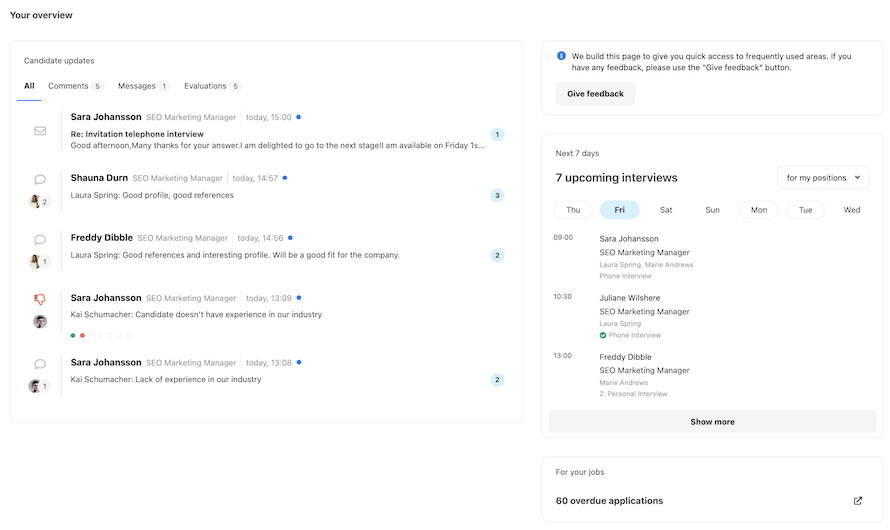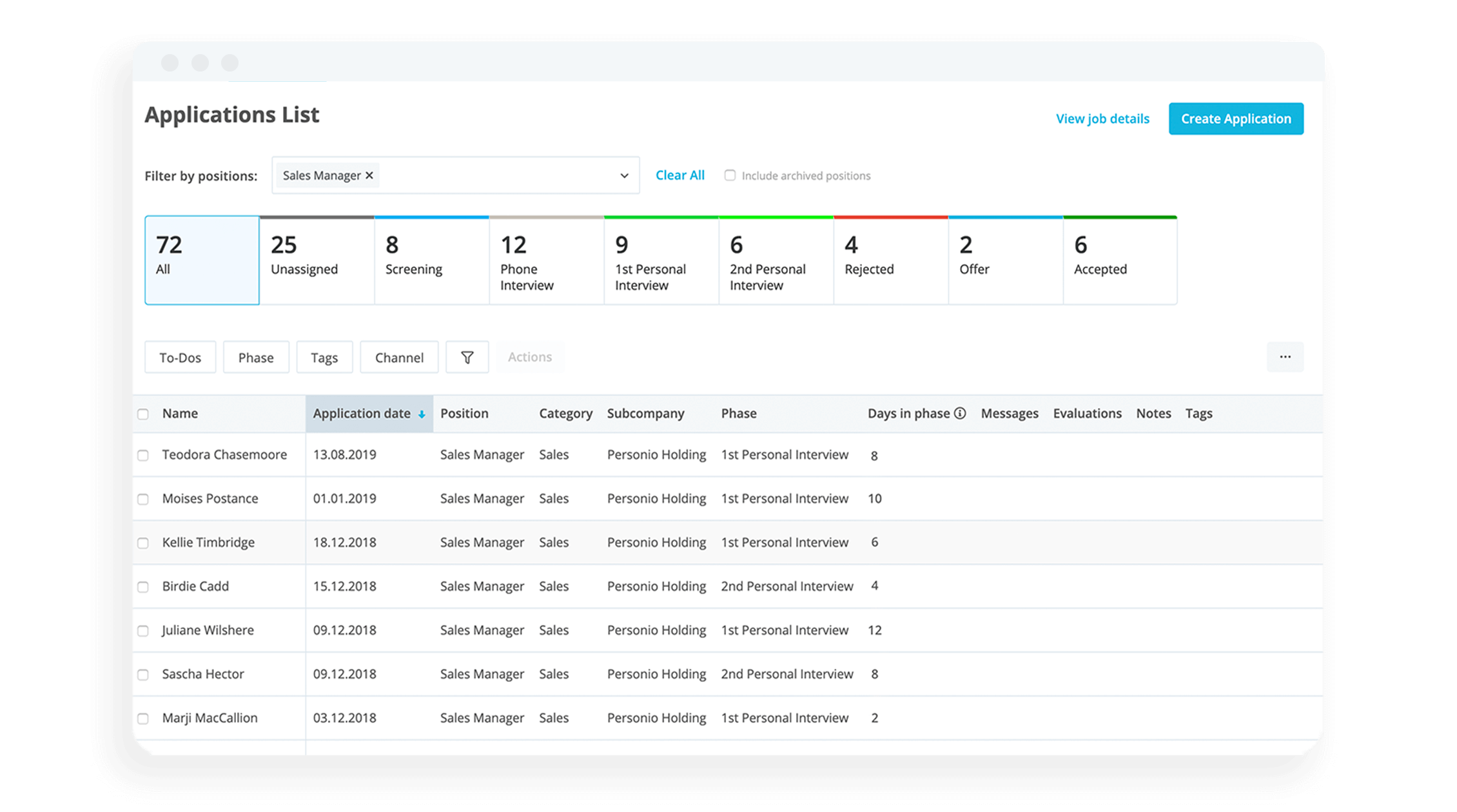
Streamline your hiring process
Explore effective strategies to enhance your recruitment process and attract top talent.
Read our guide9 Best Recruitment Methods for HR to Use

Recruitment methods come in all shapes and sizes, but which work the best? It depends on your ideal candidate, what you need from them and where they can be found. In this article, we’re detailing the nine methods you can use to find your next great hire.
Hire in record time with a leading Applicant Tracking System (ATS).Proactive Versus Reactive Recruiting Methods
Writing a job advert and putting it on your website is only half the story. From the very beginning, you need to make a conscious decision about the hiring tactics you want to employ. More often than not, this will be driven by context.
So, if we expand our lens a bit, we can see two distinct “camps” of recruitment methods:
Reactive recruiting
Proactive recruiting typically occurs when a hiring team has a job description and an untapped pool of candidates. They have to go and find the talent they need.
On the other hand, reactive recruiting is typically in response to an organisational change. This could be the sudden resignation of a key employee or a change in org design.
Now, let’s talk about each of the recruitment methods you may want to start using today:
The Top 9 Recruitment Methods You Should Use Today
1. Employee Referrals
An employee referral program consists of employees referring people they know for a company’s open roles (typically in exchange for a referral bonus).
In this case, candidates are vetted by your existing staff to ensure that they are already a great fit in terms of qualifications and company culture.
Employee referrals are also good for employee retention. In a study by ICIMS, 50% of referrals retained their employment for at least 38 months, compared to 22 months for non-referred hires.
However, the risk is having a limited pool of candidates, which is not good if you are trying to build a diverse workforce. In fact, your talent pool may not represent the external workforce overall.
As far as agility is concerned, referrals can help replace key positions much more quickly. Mainly because the “cultural fit” of a hire is already somewhat sorted.
2. Job Boards/Job Postings
Posting on online job boards is another standard recruitment method. To find the right candidate, you need to be strategic with the type of job boards you post ads on.
Job boards speed up your recruitment process because they have a global reach and can result in instant applications. Popular sites like LinkedIn, Monster and Indeed attract many applicants, so it can be helpful for organisations that aren’t as well-known.
But, a poorly-designed job board can turn away candidates due to poor UX. Moreover, resume keyword searches can exclude qualified applicants or discriminate against them.
Cast the widest net possible with Personio Posting Bundles today.
3. Online Advertising
Did you know that most applicants go to Google to look for their next job?
If you want to increase your application and time-to-hire rates fast without the time and effort committed to SEO and employer branding, paid advertising is the way.
You can place your job ads on Google by paying for them. You select the keywords or phrases relevant to your company or open role. You write ad copy for your job ad with links to your career site or the vacancy itself. Similarly, you can also advertise on social media like Facebook and Linkedin.
Paid advertising can be cost-effective because you only spend money when a candidate interested in the role clicks on it. And you can also track and measure your job advertisement results.
But, if you don’t target the placement of your ads well, you could attract unsuitable job seekers or get too few applications. Hence it could also be a costly recruitment method.
Offer an Amazing Candidate Experience With Personio

Hire the right employees faster with Personio’s Applicant Tracking Software (ATS). Communicate with talent, easily create job offers, and turn candidates into employees with a single click.
Start A Seamless Candidate Experience Today4. Social Media
According to Randstad, 39% of candidates use social media to find their next job. And with a reported 84% of companies using social networks to recruit, it makes sense to also do the same.
Posting jobs on your LinkedIn, Facebook and Twitter pages can dramatically accelerate your reach, allowing you to access a virtually unlimited network of candidates.
You can also effectively promote your employer brand by sharing employee reviews and giving them a glimpse of what it’s like to work for your organisation.
Directly engaging with candidates via likes, comments and DMs can help you establish relationships with your candidates for your current vacancies and future job opportunities.
On the flip side, social media recruiting is labour intensive. You need a personal touch for it to be effective, not automated responses. It also requires more time than the conventional resume collection and screening.
5. Recruitment Agencies
Recruitment agencies are an excellent choice to help you address hard-to-fill roles. They offer tailored staffing services and have access to an extensive network of potential candidates. It also keeps your time free to concentrate on your core business operations.
In addition, you can also tap a recruiter to contact a particular talent that works for your competitor. If you don’t want to make direct contact, a headhunter can do that for you.
Undoubtedly, using a recruiter costs money. Fees usually are around 20% of the placement’s salary. And some candidates prefer to directly contact the employer than apply via a staffing firm.
6. Recruitment Events
Recruitment events can vary, from job fairs to hackathons and school/campus events. They can be conducted face to face at universities or virtually like Amazon’s Career Day.
Aside from Amazon, Lego organises Brick Factor, where 100 competitors finish building challenges to win the title of Master Model Builder and gets hired on the spot.
Meanwhile, IBM holds DevelopeWeek. It is the biggest developer expo and tech conference series globally, with over 8,000 attendees in New York, Chicago, and Austin.
For large organisations or companies that are scaling, it can be effective for quickly attracting a large mass of new applicants. It is also good in terms of raising employer brand awareness.
However, you could face stiff competition from other companies participating in the same job fair. Or, you may find yourself spending money on your booth just to stand out. And, since there are so many potential applicants, you may ultimately struggle to screen all of them.
7. Passive Candidates
A passive candidate has the right skills and qualifications for your open role but is not in the market for another job. These individuals are generally happy with their current employers and have positive employment records.
However, you can make them switch with the right timing, role or offer. You can reach out to passive candidates via social media, referrals, professional organisations or by word of mouth.
You may also be eyeing a competitor’s top performer to work for your company. Since it would be unethical or hard to contact them directly, you can outsource your passive candidate hiring with a recruiter or headhunter.
Similar to recruiting via social media, engaging with passive candidates takes time. You need to nurture them via multiple touchpoints like texts and company emails, and newsletters to build relationships that will eventually lead them to become your future employees.
8. Professional Networks
Flexjobs define a professional network as a broad group of colleagues and industry contacts who can either speak specifically to your work experience and accomplishments or offer a personal endorsement of you as a potential hire.
As of 2019, some of the most extensive professional networks in the UK are the Royal College of Nursing (RCN) with 435,000 members, the Association of Chartered Certified Accountants (ACCA) with 208,000 members, and the Institution of Engineering and Technology (IET) with 168,000 members.
People register with the appropriate professional association. And usually, these associations require candidates to have the necessary licences, certifications or qualifications to be accepted.
Once you are connected with the candidates, you can host coffee meetings, phone calls or video calls to get to know them and proceed with the usual recruiting process.
Just like employee referrals, the downside of the professional network is the limited pool of applicants, which can hurt your inclusive hiring efforts. You may overlook equally qualified candidates because they are not part of your professional network or association.
9. Talent Pool Database
To save on recruitment spend and effort, leverage your talent pool for suitable applicants not hired previously. Search your talent pool for similar experiences and skills when a new vacancy arises.
To build your talent pool, you need to source candidates across industries and organisations, like sourcing directly from specific colleges and universities specialising in certain degrees.
Other sourcing resources include alumni associations, LinkedIn contacts, previous employees, employee referrals and contingent workers. You can also build an internal talent pool database by identifying current staff showing potential for advancement.
Maintaining a talent pool can be time-consuming. You need additional resources to make sure candidate data stays up-to-date to reap its benefits like reduced cost and time per hire.
Streamline your sourcing efforts with Personio today.
Do Certain Recruitment Methods Work Better than Others?
Some studies point out that some recruitment methods yield better results than others.
In the latest Gallup State of the American Workplace Report, 71% of respondents indicated they rely on referrals from current employees of an organisation when performing a job search.
Meanwhile, 58% of respondents cited looking for online job sites like Monster and Career Builder when looking for their next employer.
47% of respondents said they use the professional network LinkedIn when looking for a job. And 41% use professional or alumni organisations to source their subsequent roles.
Meanwhile, talent pools can reduce sourcing costs by 25-50%. To that end, a talent pool (with its ready access to a live talent community) can be your solution to reduce your cost per hire.
And according to the State of Programmatic Job Advertising Report by Aptitude Research 2021, 60% of companies said programmatic advertising (or direct advertising across X amount of channels) sped up their average time to hire.
Which Recruitment Methods Should Your Team Implement Immediately?
We’ve mentioned plenty of recruitment methods, plus some statistics backing up their efficacy. But, is there a cost-effective recruitment method that a team could easily employ today?
Personio’s Job Posting Bundles is the solution. With Personio Posting Bundles, your role is promoted on the most relevant job boards in only one click, so you can quickly reach the suitable applicants you need for your positions.
